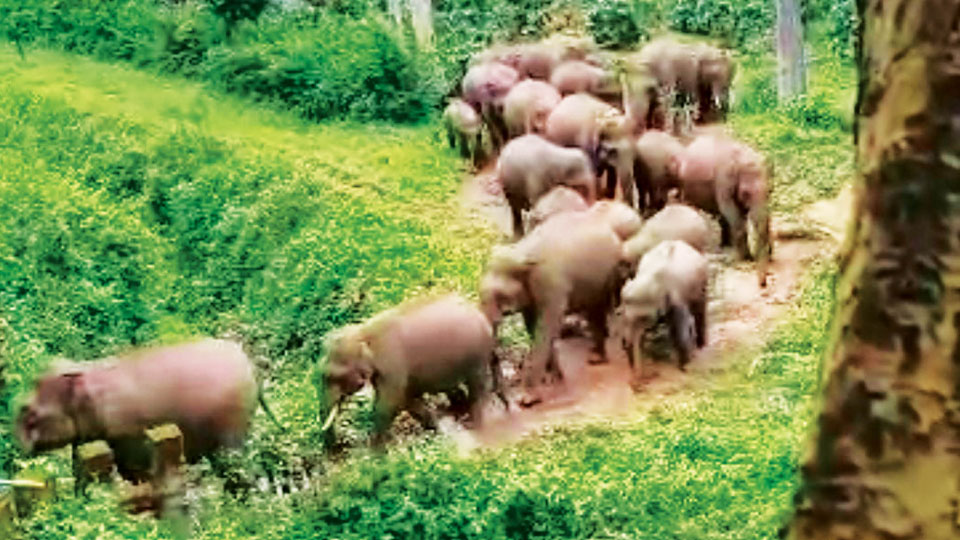By Dr. K. Javeed Nayeem, MD
It is now a very well-established fact that the nearly two-decade-old man-animal conflict in areas bordering our forests is not showing any signs of being resolved, with any degree of success.
Day in and day out, we keep reading reports about these confrontations and just two days ago there was a report in Star of Mysore about a herd of twenty-seven wild elephants having been driven out of coffee growing territory in Kodagu, by estate workers. And in the very recent past too we have read some very distressing reports of people who have been killed by wild elephants and tigers, as they went about their daily lives.
While herbivorous wild animals like elephants and bisons and carnivorous ones like tigers and leopards cannot be made to understand why they are not welcome in human inhabited areas, humans too seem to have ill understood why they are intruding into areas where they are not welcome. Among their other basic instincts, the most powerful one that drives wild animals to undertake excursions to areas outside their natural habitat, are plain hunger and thirst and their quest for food and water to quench them. There is nothing surprising or unnatural about this.
But it is a different matter that in the case of human beings, many other considerations, like the greed to acquire wealth and power, are undoubtedly the more powerful urges that lead us to do many of the shameful things that we do, as the self-appointed and sole owners of this world. That is why, we have been seeing and are still seeing all the injustice, warfare, bloodshed and misery that we have been inflicting upon ourselves over the centuries, in our unabashed effort to satisfy our baser instincts and pursuits.
While we as human beings, supposedly endowed with the highest levels of intelligence, never take note of how errant our own behaviour is and do nothing to correct it to make our lives more livable, we expect animals to mend theirs!
That is why we make a big hue and cry over how our lives are being tormented and our livelihood is being disturbed, by the activities of animals with whom we share our living spaces. But sadly, none of us including our so-called experts in wildlife management, seem to have understood why this man-animal conflict continues to torment us. Various theories keep getting propounded from various quarters, both qualified and unqualified, but they all have proved to only be absurd because we do not seem to be making any progress in solving the problem. Some of these theories seem very comical too.
Very recently, some expert has announced that it is the excessive proliferation of the weed, Lantana camara that is responsible for driving animals out of our forests. Lantana, originally a native of Central and South America, has been the commonest and most abundant wild shrub, that we see all around us. Little has our expert understood that humble Lantana has been peacefully sharing its living space with every one of our wild animals, over two centuries, ever since it was brought to India by the British.
In fact, what we are now blaming as the culprit, has been providing a roosting place for many of our birds, reptiles and smaller mammals which abound in our forests today.
For the denizens of the forests, because it is plain hunger and thirst that forces them to step outside their natural habitat, addressing this need is logically the most sensible solution. What our forests hold now, by way of food or tranquil living space, clearly seems to be inadequate to give their inhabitants what they need.
That is why they are being forced to seek these two bare necessities outside where they once used to. Talking of food first, our so-called forests, though lush and green in appearance, do not seem to be having sufficient vegetation of the kind that gives sustenance to animals like elephants and bisons, which have massive appetites. This deficiency is thanks to our nearly century-old practice of encouraging monoculture by planting timber yielding trees like teak that provide no nourishment to wildlife.
A drive through any of our wildlife sanctuaries will make us understand how rampant this practice is. You’ll hardly find any other kinds of trees, especially the ones that provide fruits or berries or low-level foliage that animals can relish. The bamboo too, a favourite of foraging herds of elephants, that once used to be abundant, has almost done the disappearing act. This is because of the natural life cycle of the plant that makes it die every twelve years or so, which it has been doing over the last few years. But we do not seem to be doing enough to replenish it.
In comparison to what our forests hold today by way of food, coffee estates that border them seem like virtual Edens to hungry animals. This is because they hold plenty of fruit trees like orange, arecanut, jackfruit, jamun, wild figs, banana and the Malanad toddy palm (Caryota urens), all of which are the hot favourites of hungry jumbos!
Once animals like the elephants and bisons taste these treats, all other fodder found in the forests naturally seems very insipid and tasteless. So the key to setting right the present problem seems to lie in replenishing food and water sources for wild animals, right inside their natural habitats.
Carnivorous animals like tigers and leopards too come into the news from time to time, for making the lives of humans difficult and dangerous. And this is despite the fact that there’s no dearth of food for them in our forests.
The reason for this confrontation seems to be the encroachment made by us with our agricultural activities, into what were once the buffer zones between their territory and ours.
It is important to understand that it is not enough for these animals to just have their living space. Because they are very apprehensive of human presence, they also need to have clear stretches of what can be called no-man’s land between their land and ours.
These are a few of the points that we all seem to be missing when we complain of being put to much inconvenience and peril by the ongoing man-animal conflict. That is why we have not been able to do anything significant in resolving it despite spending huge amounts of money over it.
Just recently there was a statement from our Chief Minister that we need to spend another rupees three hundred crores over this effort, before we can see some much-needed results. But in my opinion, unless we get to understand the etiology of the problem, this too will go down the drain and only turn out to be money ill-spent!
e-mail: [email protected]








Recent Comments